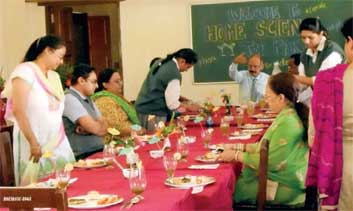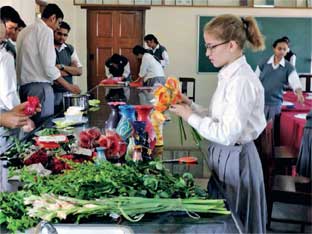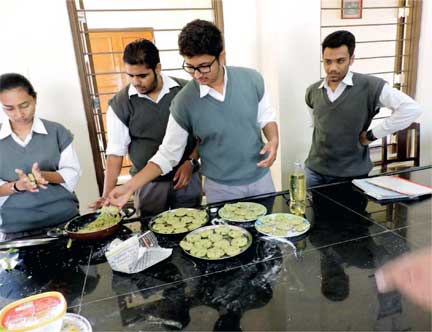Alaukikaraje Gaikwad Khachar
In today’s pandemic-wrought world, we have all found refuge in our homes. At this dramatic moment of history, where everything has lost its permanency, it is the home and family which have rallied around us. Then why is it so difficult to think of a discipline of study that focuses on understanding oneself in context with the family?
The visionary ruler of Baroda, Maharaja Sayajirao Gaekwad III had foreseen the importance of a subject like home science way back in 1926. Speaking to school girls in Mumbai, he had said, “To make the world a better and noble place, India will need a Jane Addams in every slum, a Pandita Ramabai in every district, a Florence Nightingale in every hospital, and a Margaret Macmillan in thousands of schools, besides skilled and intelligent mothers and wives in scores of millions of homes.”

It was the princely state of Baroda that first introduced home science at the secondary school level in India. Home science today is an integrated science aiming at improving the quality of life for the individual, family and community. It empowers students with skills to improve every facet of home life – food, clothing, health, child care, personal finance, culture, beauty, etc. It teaches students their rights and duties as consumers, and enables them to take better care of their families whilst leading a more complete and enriched life. The name home science may sound old-fashioned and cliched but its area of study encompasses a wide number of specialized career choices.
The CBSE course in home science covers five areas – food and nutrition, human development and family studies, fabric and apparel, resource management and communication and extension. Each domain contributes to the study of the individual and the family in the Indian social cultural context.
My story begins in one of our country’s oldest public schools which was primarily a boys’ school. In 2014, a young girl walked in through the gates of the Rajkumar College, Rajkot seeking admission in the 12th grade. A rare event, and home science being her choice of subject was even more extraordinary. It was exciting and we offered it then even to the new batch of standard 11.
Teaching the course had a number of surprises in it. We used the theory – practical research interface model which is inherent to the home science discipline. Since we were teaching the course for the first time we used the co-teaching method. Four teachers taught the students the various specializations. This had miraculous results. It encouraged interaction between staff from various departments. The economics department taught the resource management and banking aspects, I taught human development and family studies and communication extension, one of our preschool staff members happened to be a fashion technology graduate so she dealt with that course and we discovered a food and nutrition major in our computer department and so she chipped in too. It fostered team spirit amongst all the staff and each of us enjoyed teaching our specializations. The students carried out interviews, went on field trips to weaver villages, they planned menus for the school mess and the course was interwoven into SUPW work too.

Just as the staff enjoyed teaching the course, the students discovered that home science was not what they thought it was, in contrast it opened a box of surprises for them. Speaking to some of the present and past students I got these reactions.
It was new. It was interesting. It was different to anything I had studied before. Learning about adulterants in food, was of special interest to me. My visits to the slum, helped me appreciate and feel gratitude for the kind of life I have. (Shagun Mishra; std 12)
It was definitely not cooking and stitching as I had earlier imagined. It was a total action-packed curriculum with not a moment of boredom. Even today, whilst studying for BA, I recall the home science course and the skills I developed in the process. It has helped me to understand my family and friends better, it helps in organizing and saving my pocket money and it helps me in my choice of food too. (Nazfareen Palia lives in a hostel now in Mumbai)
Within a span of five years, the demographics in the home science class have changed. There are many boys opting for it and interestingly, many academically good students too wanting to do it. Speaking to Harsh, I realized his mother had been a home science graduate and was ever grateful that we had started it in the school. Home science laid the path for his career choice and he is now studying Hotel Management in Rajkot. “I plan to open a restaurant that serves healthy fast food,” he proudly announces. “I enjoyed my home science classes and not once have I regretted my choice. During the lockdown, I have been an even more useful person in my family and when we could not go out and had to make all our resources last longer, I thanked home science.”
This year the number of students opting for home science has grown considerably from our humble beginnings of six students. The credit goes to Jaidevi Rathod, an enthusiastic teacher and a home scientist. She says she always notices a major attitudinal change in the students after one year of home science.

The students learn to appreciate what they have when they notice and work in other institutes and with people less fortunate than themselves. “Once during a visit to the old-age home, one of our students actually broke into tears seeing the condition of the inmates there,” she says.
We found students wanting to pursue careers in the medical field or hotel management industry. Two or three students have gone ahead to study various specialized courses like looping, beverages and food technology.
As teachers, we do face certain logistical challenges as the course entails a lot of preparation on the part of the teacher with respect to procuring raw materials for the practical classes. Also many field visits have to be arranged and institutes organized for field work.
RKC girls have worked in slums, adopted a village and taught village girls about menstrual hygiene. Through their home science course I have seen them understand themselves and realize that the turmoil and annoyance they felt towards parents and siblings was very often common to most young adults their age. These young adults developed skills to tackle challenging situations and become responsible and productive members of the society.
Thus the purpose of home science at the school level is to create an environment and develop an outlook in learners to enable them to live a richer and more purposeful life, become future ready and develop 21st century life skills for personal and professional life. All the domains within the home science discipline provide ample scope for professional avenues of higher education and career.
In class XI, the “self and family” and the “home” are focal points for understanding the dynamics for individual lives and social interactions. In class XII, the emphasis is on “work and careers” through the life span.
Living in a smaller city, I sincerely advocate the inclusion of home science in the higher secondary school curriculum. It would add real meaning to education.
The author is an alumni of the MS University, Baroda, and ex-Vice Principal of Rajkumar College, Rajkot. She is also a dedicated and enthusiastic learner and teacher running her own school for the underprivileged in Jasdan, Gujarat. She can be reached at alaukikaraje@hotmail.com.
